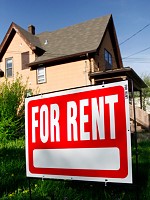When a Tenant Moves Out – Part 1
Posted on June 29, 2011 by Earlier this month, three investors visited our ranch. They were having a lot of trouble with their rental properties. In addition to high turnover rates, when the tenants moved out, they left the homes a wreck. The investors wanted to know how to more effectively manage rental properties and tenants.
Earlier this month, three investors visited our ranch. They were having a lot of trouble with their rental properties. In addition to high turnover rates, when the tenants moved out, they left the homes a wreck. The investors wanted to know how to more effectively manage rental properties and tenants.
They couldn’t have picked a better time to visit. Two of our properties had just gone vacant. The first property was a high-end home – the husband had been hired by the FBI. The second home was in a tool-belt neighborhood – the couple had just bought their first home.
When the investors saw the condition of both of our properties, their jaws hit the ground. The yards were cut, flowerbeds weeded, floors vacuumed, cabinets cleaned, and the bathrooms were spotless! Truly, with almost no work on our part, another tenant could have moved in that day!
So how did we accomplish this little miracle? How did we get back two properties at the same time with both being in incredible, move-in-ready condition? Did I sprinkle some kind of magic fairy dust? Did I rub a lantern and a genie granted me three landlording wishes?
Being a successful landlord is a worked-at, strived-for, thought-out thing. Fairy dust and genies have nothing to do with a landlord’s success! Here are just a few of our landlording secrets that help us get a property back in a clean, ready-to-rent condition.
First, we never call tenants “tenants.” To us, they are residents. Think about it: tenants treat a property one way, while residents treat it another. I know, this sounds corny, but the sooner you start thinking of your CUSTOMERS as RESIDENTS, and yourself as a PROPERTY MANAGER and not a LANDLORD, the better. (Yes, I know it’s an ego boost to say, “I’m a landlord!” but keep it to yourself.)
Second, before we select a resident, we verify everything on their application. We also do a criminal background check. Finally, if all looks good, we inspect the property where that person currently lives – both inside and out! Remember: However their current residence looks now, is exactly how your property will look two weeks after they move in!
Third, before signing the lease, we email a copy of the document to the resident. We want the resident to have time to carefully read our lease – which is written in plain English – and ask any questions that come up. We also want to make sure they understand that we will regularly inspect the property, inside and out.
Fourth, at lease signing, we collect ALL monies owed – the security deposit, that month’s rent, etc. The funds must be in cash – we’ve learned the hard way that if we’re paid with a personal check and it bounces, the resident is already in the property and we’re forced to spend time and money going through the eviction process. NOTE: Once the resident is in the property, they can pay rent with a personal check.
Finally, and this is BEFORE we sign the lease and the resident gets keys, we have the resident fill out and sign a Move-In Inspection Form – and they receive a copy for their records. On this form, they note the condition of the property and any preexisting damage they find. NOTE: This form is CRITICAL at move-out time!
In next week’s column, we’ll discuss what we do when a tenant decides to move!
 Bill & Kim Cook are a husband and wife real estate investing team. They live in Adairsville, Georgia and have been investing in real estate since 1995. They specialize in buying single-family homes, mobile homes and mobile home parks. They also run North Georgia REIA and teach folks how to successfully invest in real estate.
Bill & Kim Cook are a husband and wife real estate investing team. They live in Adairsville, Georgia and have been investing in real estate since 1995. They specialize in buying single-family homes, mobile homes and mobile home parks. They also run North Georgia REIA and teach folks how to successfully invest in real estate.